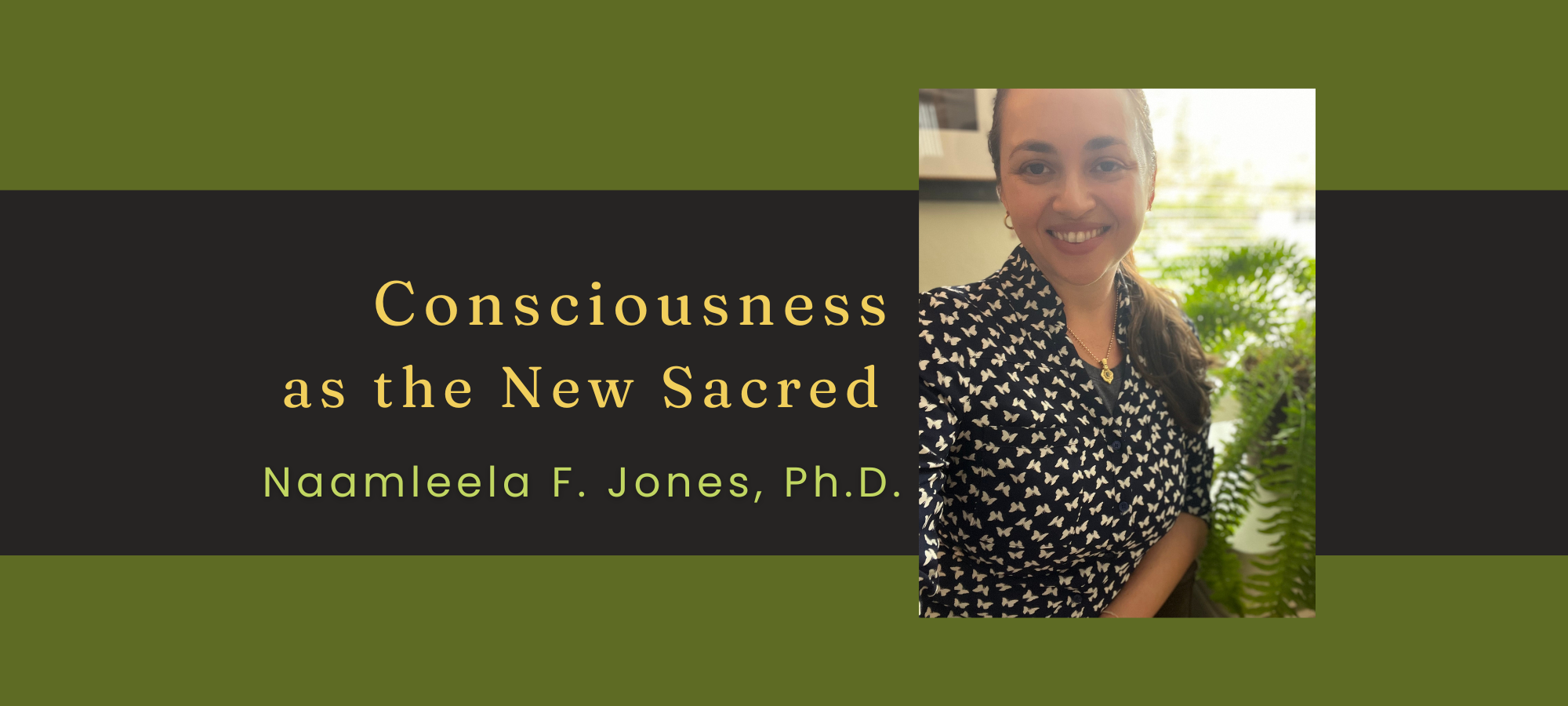Dr. Naamleela Free Jones is an editor of Correspondences: Journal for the Study of Esotericism and adjunct faculty of Pacifica’s new M.A./Ph.D. in Psychology, Religion, and Consciousness Online Program. In this article, she brings a depth psychological lens to consciousness and “the loss of the sacred in modern life.”
I come to the study of consciousness through the lens of religious studies and the History of Religions school. I was born in Northern California in the early 1980s and raised in a spiritually experimental environment, shaped by East-West dialogues and countercultural ideas. That early influence sparked my curiosity about the deeper, shared dimensions of existence—curiosity that eventually led me to Rice University, where I trained in the study of esotericism, mysticism, and the so-called “impossible” dimensions of human experience. I was fortunate to work with Jeffrey J. Kripal, who taught me to think alongside figures like Mircea Eliade, Sigmund Freud, and William James—thinkers whose work continues to shape the field.
I’ve always been convinced of the importance of the study of religion. When John Kerry was Secretary of State in 2013, he said, “If I went back to college today, I would probably major in comparative religions, because that’s how integrated it is in everything that we are working on and deciding and thinking about in life today.” Religion shapes so many aspects of contemporary life, that studying it not only deepens our understanding of history and culture but also equips us to be more globally aware citizens in an increasingly complex world.
But as Ralph Waldo Emerson said in his 1838 Harvard Divinity School address: “They call it Christianity, I call it consciousness.”
The history of religions is also a history of consciousness. Often in religious studies, we don’t study consciousness directly. We don’t even claim to fully understand what it is. But we do study how it is reflected and refracted in culture. We account for it as a central dimension of human experience, and we approach it by exploring how it reveals itself—through symbols, myths, and the dreams of the imagination, coded deep within our psyches. This is exactly what Pacifica tends to so beautifully.
More and more, I’ve come to see that everything we study revolves around this question: What is consciousness? It is the state or fact of being aware. It is the single thread that connects us all. We are conscious beings living in relationship with all other conscious beings.
And still, what it is remains a mystery. That brings us to what philosopher David Chalmers called the “hard problem” of consciousness: How is it that we are conscious at all? Chalmers recognized that consciousness is a fundamental aspect of human existence—yet it remains the one question we can’t seem to fully answer. Similarly, the sacred has been defined as the ineffable, that ultimate aspect of existence that remains beyond our grasp. This suggests that consciousness, like the sacred, may be something central to reality itself.
Eliade, James, and Carl Jung all shared another concern: the loss of the sacred in modern life. They worried that modernity has disenchanted us all, disconnecting us from the deeper dimensions of existence. And that was before we started living half our lives through our phones. Jung called this disconnection the “spiritual problem of modern man.” He argued that psychological and spiritual renewal could come through reconnecting with the sacred—only, that would not necessarily happen through traditional religion, but through new forms of meaning.
If we begin there, we find a powerful premise. We can study consciousness as the new sacred. We can see that as many traditional religious frameworks lose their authority, the sacred is not disappearing—it is transforming. Studying consciousness today is interdisciplinary, combining spirituality, religion, science, psychology, and more. In making it the center of our study, we are not circling back to a past era or limiting ourselves to a single discipline. Instead, we’re envisioning a new way forward.
Next spring, I’ll be teaching Foundations of Consciousness for the new M.A./Ph.D. in Psychology, Religion, and Consciousness Online Program. I’m excited. We’ll start with the basic question “What is consciousness?” and move from there through foundational theories, from materialism and dualism to panpsychism. This course is designed to equip students with the essential tools they need to navigate and critically engage with the landscape of consciousness studies. Along the way, we’ll grapple with some of the most persistent and unresolved questions in the field. We’ll dive into the work of physicists like David Bohm and Harald Atmanspacher, as well as modern-day thinkers like Iain McGilchrist and Vandana Shiva. The following spring, I’ll teach Yogic Psychologies of Consciousness, which will expand on this foundation by exploring the multifaceted Indian traditions of yoga.
I’m looking forward to this new program at Pacifica because I believe the study of consciousness allows us to tackle some of life’s big questions directly, while thinking in deep and comparative ways. And it is one of the last great mysteries. In a sense, it has replaced God as the thing we cannot explain yet cannot deny. For thousands of years, the sacred, however it was defined, was out there—on mountaintops, in temples, in texts. Today, rather than being confined to traditional frameworks, we can find the sacred right here—in the very nature of consciousness itself.
To learn more about the M.A./Ph.D. in Psychology, Religion, and Consciousness Online Program and how to apply for Fall 2025, visit us here.

Naamleela Free Jones, PhD, is a scholar-practitioner, educator, and musician deeply immersed in the world’s esoteric and mystical traditions. Her research focuses on contemporary esotericism and consciousness studies, exploring how gnosis, nonduality, and the sacred are being reimagined in today’s post-traditional contexts.


